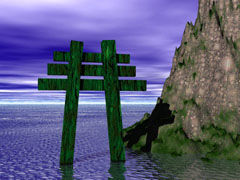Shinto at a Glance

Like China, Japan has amalgamated three distinct yet interrelated religious traditions. Confucianism entered the country from the mainland in 405 C.E. through the Korean scholar Wani, and served mainly as a guide to ethics and filial relationships. Buddhism came from China by way of Korea during the 6th century. And Shinto, the native folk religion of the islands which dates from before the Christian Era, still survives in a variety of formats. One reason Shinto has proved of so little interest to Westerners is that it is viewed as essentially a state religion based on ancestor worship related to the Japanese Imperial Family. (Try to imagine a state religion in Great Britain based on ancient Celtic or Druidic rituals but serving as a vehicle for the worship of Queen Elizabeth and Prince Charles.)
But the image of Shinto as ceremonial state religion is inaccurate. Its name is actually derived from the Chinese terms shen and tao, meaning “Way of the Gods,” and was coined retroactively in the 6th century to distinguish the native religion from the new import, Butsudo, or “Way of the Buddha.” The practices and beliefs of Shinto are ancient, combining nature-worship and animism (the belief that personal, intelligent spirits inhabit almost all natural objects, from stones and rivers to animals, trees, and hills) with ancestor worship (which, as in the Chinese and Aryan traditions, often included the glorification of tribal heroes) and a great emphasis on ritual cleanliness. All these features are still part of modern Shinto, and of Japanese cultural life in general. Ritual ablution, for instance, is not performed only before worshipping at a shrine, but also in purifying restaurants and other public places with cones of salt (reflecting the salt water with which Japan is surrounded and which was used in the earliest purification rites).
Shinto was the national religion of Japan until about the 9th century, when Buddhism became dominant for much of the next millennium. But Shinto developed its own distinctive theology during the 15th and 16th centuries and re-emerged as the official state religion following the Imperial Restoration of 1868. That revolution ended the successive dynasties of shoguns, or military governors of Japan, and ushered in the modern era. During the Meiji period (1868-1912), Shinto was elevated above all other religions, which were forced into virtual seclusion for a time, and was used as a tool of government to advance various Japanese war efforts. In effect, Shinto and the concept of the emperor’s divinity became a shield for the Japanese militarists who had transformed Japan from an isolated society to a military and industrial power capable of defeating China and Russia. The militarists succeeded; until World War II, Japan had never lost a war. But the cost was terrible, not least for Shinto, which changed from a naturalistic peasant religion to a cult of blind patriotism.
Next – Shinto Records and Chronicles »


